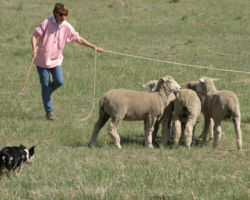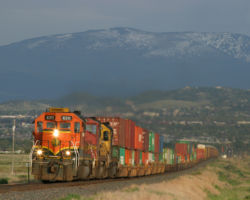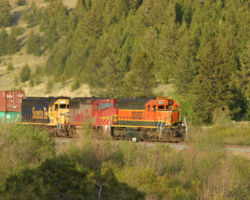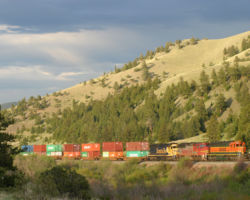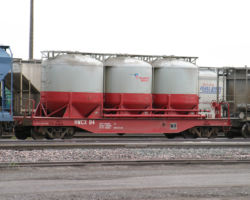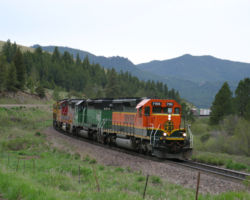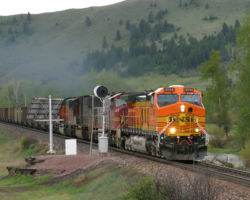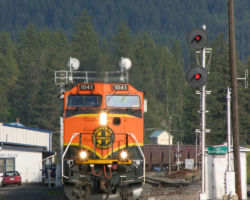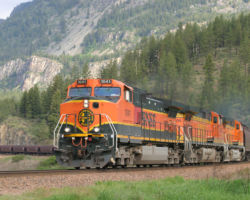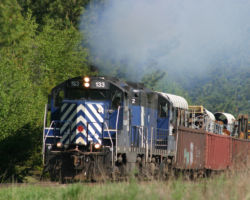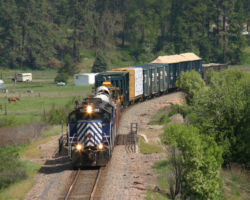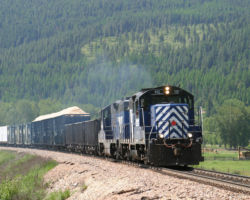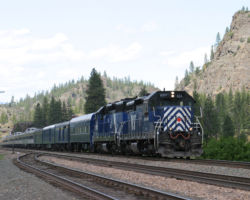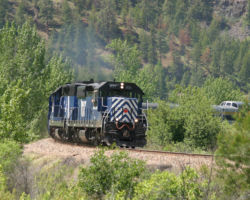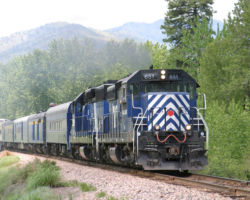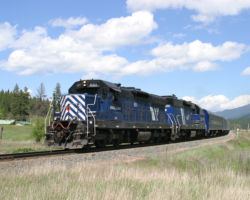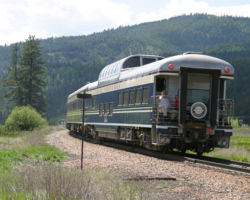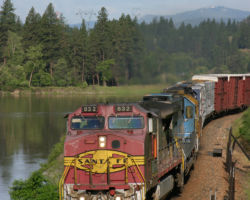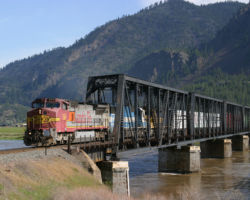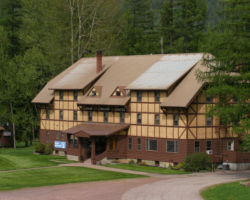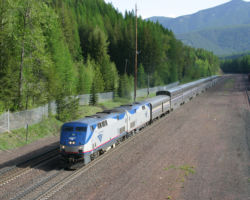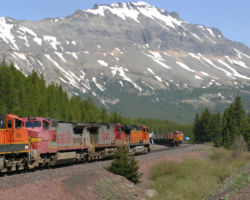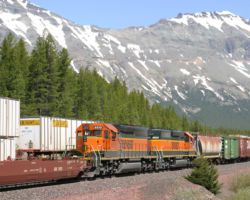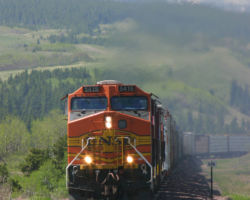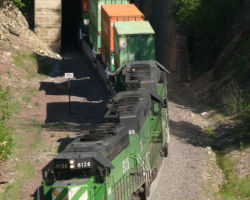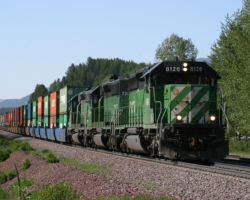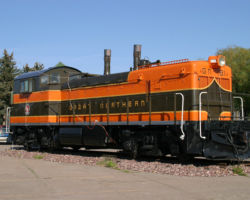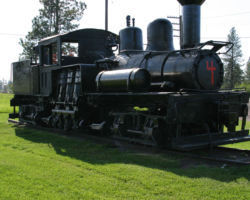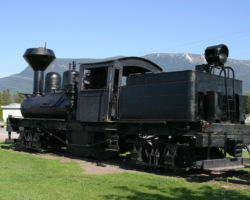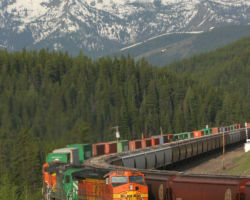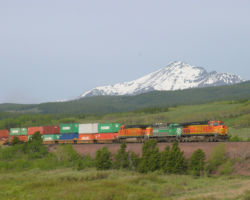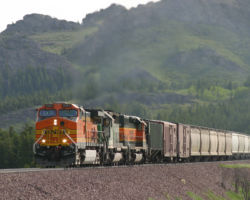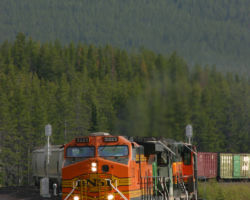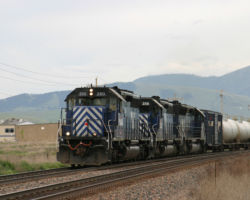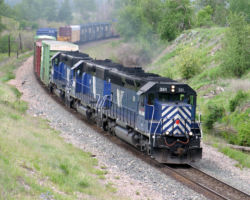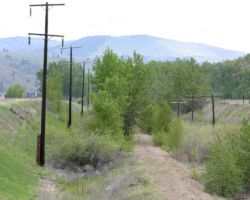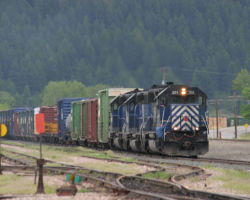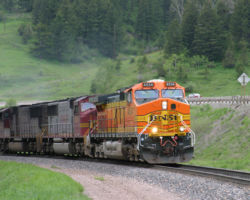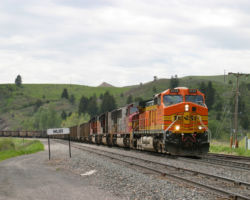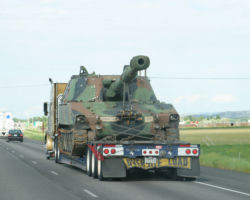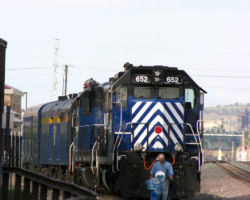Saturday, May 24, 2003
As many of you know, May and June are always my big travel months. The first half gets consumed by a couple weeks on the road for work, and the last half gets used for a couple weeks of personal vacation. My company’s fiscal year ends on May 31, so I have to burn any unused vacation by that point – and generally I have quite a bit left to use. Unlike last year’s big May trips, both of which received at least a rough couple weeks of planning, this year’s were a bit more spontaneous. As far as work goes, I got switched at the last minute from Brussels to Las Vegas and then finally to Memphis for work (field software testing). (For you south-central railfans, Memphis and the surrounding area will get addressed in an upcoming trip report, but I decided to split the two up this year. Be patient…) For my vacation, I decided it was time to go hit Montana again, specifically the MRL and BNSF mainlines across the western part of the state. As an added bonus, it was country that my wife hadn’t seen before, and as such it’s usually pretty easy to convince her to visit such places.
The first day wasn’t actually a day at all – it was just home (Colorado Springs) to Douglas, WY, after work. I figured as long as we were headed for Montana, we might as well pass through the Powder River Basin. After all, I hadn’t been back in a couple years and I thought I’d see if I could do a bit better shooting it with the newer camera and bigger lenses. For those headed for Douglas, though, I’m going to offer my first bit of travelling advice (and there will be a fair amount of it in this report) – avoid the Douglas Super 8 like the plague. There’s nothing like arriving at your motel for the night to discover big pink signs from the WY Department of Health warning of very high levels of toxic mold spores in the air. My wife is slightly allergic to mold, so it wasn’t exactly a great night, but everybody else was booked full.
Needless to say, we were both up and out of the fungus farm pretty early in the morning. Neither of us is particularly a morning person, but it was good to be out of there and on the road. Plus, getting an early start is almost essential to photographing trains on the south end of the Basin, as the road is on the east side of the line.
However, like all vacations, they start best with traumatic events, especially those involving the vehicle you’re driving. Not more than a couple miles out of Douglas, a golden eagle took off from out of the ditch right in front of me and wound up spread across the entire (brand new, three day old) windshield. By the time of impact, I’d gotten the truck down to about 45, but it was still a good enough hit to make me think it would probably break the glass and kill the bird. He tumbled backwards over the top, and I heard my scanner antenna get knocked off in the process. Looking back, though, the bird landed on the road, picked himself up and shook himself a bit, and then took off again for a nearby hill. Apparently it wasn’t that bad of a hit, if he could still fly – and consequently, this beautiful flying road hazard gets top billing in Photo #1 (as the lower of the two eagles).
The PRB was its usual self – antelope and coal trains everywhere, with a nasty westward wind blowing the whole time. Unfortunately, since we actually did have a few miles to cover, I couldn’t take every back road looking for the perfect shots. I pretty much had to stick to the highway – after all, I’d hoped to catch some MRL action later in the day. However, I did get a few coal trains, and a few hundred more coal car roster shots for RailARC just to annoy Michael. One of the more notable shots was this one of UP 5944 southbound with a load at Bill, WY. The amount of coal dust blowing off the top should give you a very good idea of just how windy conditions were that Saturday.
The rest of the drive from Gillette to just outside Livingston, MT, was fairly uneventful. I had the scanner going from Billings west, but never did hear a thing. Then, just a few minutes from Livingston, I saw a headlight appear from under a bridge passing over the freeway. The train itself didn’t interest me that much – unlike I’d hoped, it was just an eastbound BNSF junk train. However, there were four ex-BC Rail SD40-2s buried a few cars back in the train, which more than justified the 20 or so minutes I’d need to successfully chase it down and get the shot. My brain had been keeping tabs of potential photo spots since leaving Billings, and after a bit of thinking I decided the East End exit (MRL Second Sub MP99.3)was probably my best chance. At that point, there’s a public crossing right off the freeway and the line is running more north-south than east-west. That would help to alleviate backlighting effects. So, back to the East End exit we went, only marginally faster than the train itself. Less than a minute after I was out of the truck with the camera in hand, BNSF 5345 east shot past (Photo #3), followed by the four ex-BCR units I really wanted (Photo #4). [As a side note, the last time I saw BCOL 757 was two years prior. See the fourth chapter of my British Columbia trip report.]
After grabbing a bite to for my wife to eat in Livingston and checking into the motel – a Comfort Inn just off the freeway (and a very great improvement over the previous night) – I heard horns to the east of town. I’d planned to go find something to eat myself, but instead I ditched my wife at the hotel (as she was a bit tired of being on the road) and headed out west to hopefully catch the train going over Bozeman Pass (or at least under it). Livingston has three main freeway exits, and I got on at the center one. Less than a mile after entering the freeway, my low fuel light came on. @$%^%%!!! I had great light and a train headed west into the sun, and I had no gas with which to follow it. You’d really think I’d notice these things earlier. Fortunately, for forgetful/absentminded souls like myself, there’s a gas station back up the road a bit from the west exit – and coincidentally right next to the railroad.
The train itself was nothing that exciting, as it turned out. It was a westbound BNSF intermodal with a BN SD60M on the front, followed by two Sante Fe’s – BNSF 8229, an SD75I, and BNSF 104, a GP60. Still, I’ll take a train over none any day, and the light was somewhere between good and great. The only problem was that the light was starting to fade on the east side of the pass. While there are several choices for easy access on the east side of the hill, the simplest of them all is Muir. You can get at it going west on the freeway by getting off on Exit 327 and following the frontage road about 2-3 miles up to Quinn Creek Road, or by taking exit 319 on the west side and driving the frontage road over the pass. Turn under the freeway, and you’ll arrive at Muir and within sight of the east portal of Bozeman Tunnel. There’s a small gravel area here that makes for easy parking. Also, trains are pointed into the evening sun at this point, without hills blocking the rays. After a short wait, BNSF 9262 showed up (Photo #5) and headed through the bore, only to announce he was running on a restricting signal at the other side. Needless to say, that evoked a little curiousity.
Muir is the siding on the east side of Bozeman Tunnel, and the aptly-named West End is the siding immediately through the hole on the western slope. The freeway frontage road actually goes further than the point at while it connects with the freeway and eventually crosses over the line somewhere mid-siding. However, there was something at that point indicating that road beyond that point was private property – whether it was or not I really don’t know. Regardless, the apparently public side of the crossing offers a decent evening shot. No sooner than I’d found the Yukon a spot to sit out of the way of traffic than an eastbound (Photo #6) tripped the defect detector at the west end of West End (talk about confusing!). I couldn’t have asked for better timing or placement to catch the meet – a rolling meet and I still got Photo #7.
Another easy place to catch either east or westbounds is at Exit 316 – Trail Creek Road (at least that’s what my map calls it). This works especially well for long telephoto shots of afternoon westbounds, as the canyon is well-aligned for summer sunlight. While it’s not a semaphore, the signal at MP132.2 serves as an interesting lineside prop. Fortunately, between track speed and highway speed, I found it fairly easy to catch trains between West End and this intermediate point. As a result, Photo #8 is an easy shot to get, but I still particularly like the result. It’s also the last time I’d be able to catch 9262 west that evening – track speed rises considerably to the west of the canyon.
I was going to call it a day at Bozeman, but I heard the DS mention a meet out at Belgrade with another eastbound, so I pressed on. I couldn’t resist any longer (there are few things that make me grumpier than an empty stomach), so while I was waiting for the meet to happen, I grabbed a couple of artery bombs from the local McDonalds. The eastbound in question turned out to be a heavy eastbound BNSF junk train, lead by BNSF 4882 and two other motors. Additionally, there was a five-unit manned MRL swing helper set spliced in the middle. It wasn’t the MRL-powered train I’d been hoping for all day, but as I mentioned earlier, it was better than nothing.
Because of the desire to quiet my digestive system, I actually didn’t catch up with the train until east of Bozeman. The slower speed limits and stiff grades gave me more than enough time to grab a a shot of the train from on top of the Bozeman Tunnel cut in the last light of the day. From there, it was over the hill to Muir to catch the helpers (Photo #10), and then back down to Livingston to review the day’s photos and call it a night.
The gallery was not found!Bozeman to Paradise – May 25-26, 2003
Sunday was actually mainly devoted to non-railfan-oriented activities. However, as would become the pattern for this trip, I rolled out of bed somewhere around 0600h and shortly thereafter headed out looking for rail traffic. I’m not a morning person at all, so this behaviour is unusual in the extreme for me. Typically I’m out of bed by 8 and sleepily to work around 9, but when there are trains to be had and good light, I have all the energy in the world. Strange how that works, isn’t it?
Before departing Livingston, I drove downtown to have a look around the old Northern Pacific shops. The huge shop complex is now home of the Livingston Rebuild Center, basically a locomotive rebuilder. Out on the south side of the shops complex, on the MRL itself, is a long line of units either in storage, pending disposition, or still awaiting their next assignment after being returned from the failed I&M Rail Link. (Photo #10) Sitting on the west side of the shops are dozens of LRCX GEs of unknown origin, and a few oddball units scattered about. Two of the strangest are a pair of SD18s, both presumably former Reserve Mining/North Shore Mining units from the upper reaches of Minnesota. One is former Reserve Mining 1228 with new, two-piece windshields installed rather than its traditional wide one-piece glass. (Photo #11 & 12) The other, painted in a grimey grey primer with no other markings, sits just in front and is unidentifiable without significantly closer inspection. Besides these two are former NS high hood B36-7 3817 and a wrecked, unidentifiable, partially scrapped SD40-2 in the back, bearing the number 679.
After the quick drive around the LRC, it was off to the west in search of any elusive eastbounds that might be coming over the summit in the morning light. Despite my best efforts, however, there was absolutely nothing from Livingston all the way over the hill, through Bozeman, and out as far as Manhattan. Dark signals and no radio chatter were the hallmarks of the entire drive, but it was a nice morning and there is something to be said for the tranquility of the highway. By 0930h, I was back at the hotel to pick up Michelle, check out, and head on towards the rest of the day.
The main stop for the day, at my wife’s original request, was the Montana Stockdog Challenge, being held just south of Livingston. It’s essentially a two-day competition of skill for stock-hearding dogs and their handlers, based on the ability to push five sheep through various scenarios. Both my wife and her parents dog people (especially when it comes to agility competitions), and while I was a bit hesitant at first, it really is a great deal of fun to watch. It’s something that if you have the chance and any inkling of interest, you really should go see. (Photo #13)
Somewhere around 1300h, we left the stockdog trials and headed west for the night’s stop – Helena. Once again, dark signals and a silent radio marked the most interesting parts of the trip, from Livingston over the hill and through Three Forks. However, about halfway to Toston on US 287, I did hear one call in to the dispatch. However, between Toston and Manhattan, the line is out of view as it follows the upper waters of the Missouri River (and the abandoned Milwaukee out of Nineteen Mile Canyon). Rather than turn around, I decided to press on, as the leading unit that called in was just a BNSF GE motor. Around Toston, another eastbound shot past without any warning, and needless to say I missed it. However, thanks to a detector, the third one didn’t get away. I didn’t get much setup time, but I got enough to get the grab-and-go shot in Photo #14.
Travelling beyond Townsend brought dark skies and rain. We actually arrived in Helena in the middle of a downpour, and checked in to the motel for the day, even though it was only about 1500h. After waiting in vain for about half an hour for the rain to let up, I finally resigned myself to a gloomy afternoon and decided to take a nap instead.
We both woke up again around 1700h and wandered out for dinner, again in the pouring rain. I can’t remember the name of the place now, but it was some brew pub on the west side of town. As we were eating, the rain diminished, and by the time we’d finished, the sun was starting to come through the clouds. So, I dropped Michelle off back at the motel and headed west out of town for Mullan Pass. For those unfamiliar with the area, it involves taking US 12 to west Helena, and then turning north on Joslyn Street. Go north two blocks, turn left on Country Club Avenue, which will parallel the tracks and eventually turn into Birdseye Road. After a few miles, you’ll come to a fork to Austin, and like any good railfan, follow the tracks to the left…
On my way out to the eastern flank of Mullan Pass, I ran by the Helena yard to find BNSF 6311 with a stack train, about to depart. So, I went out to where Birdseye Road turns to cross the tracks and become Austin Road and set up for a shot. There were still intermittant bursts of drizzle, but the sun was out, making a fine background of dark clouds hanging east of town. I waited through bouts of drizzle and shade, but at almost 1900h on the nose, 6311 was rolling and fighting the westbound grade, and in perfect evening light. (Photo #15)
The road up as far as the wye to Austin is in pretty good shape (paved, as I recall). Beyond the wye, it becomes gravel, but good, well-graded gravel. I was following 6311 the whole time, and was making good time headed up the pass. I finally got enough time on it just past the wye in the road, and pulled over for shots #16 and 17. Both of these are grab shots out the window of the Yukon – there wasn’t time to set up for either. I continued following the train up to Austin, but without much luck. After this point, the canyon closes up quite a bit, blocking the evening sun. After exploring a bit, I returned to town and ran by the yard one more time. That netted this MRL M-LAUMIS (Livingston – Missoula, otherwise just known as train LM) getting ready to depart the yard and head up the hill. (Photo #18) Unfortunately, there wasn’t enough light to make chasing it worthwhile.
Monday, 26-May-2003, dawned with overcast skies and rain again. Still, I figured I’d use a couple hours before my wife was up and ready to go in order to squeeze in some railfanning. The most interesting thing was only a few blocks from the motel – this Halliburton car. These interesting little critters are apparently pneumatic discharge cars designed to carry cement for oil drilling. (Photo #18) Since there was no sign of life in the yard, I headed up towards Mullan again. As I got west, the rain did break for a short time, and during that break I managed to catch BNSF 7155 and an eastbound junk train just out of Austin. Shortly after this, I gave up and headed back to Helena to get some breakfast and pick up my wife for the day’s trip west. The only thing we saw moving for the rest of the day was an empty PG&E coal train, splitting these solar-powered searchlights at Avon, MT (Photo #19A).
The goal for the day was Paradise, MT, where we planned to actually stop for a couple days. My wife and I have radically different vacation strategies, but fortunately ones that can work together fairly well. She’s more the type that would rather get somewhere and relax for a few days, whereas I tend to hold the mentality that getting there is 99 percent of the fun – a destination is just a place to eat, sleep, and turn around. I’ve argued more than once that the most relaxing place on earth for me is the driver’s seat; I’m not really much for just sitting around. Still, Paradise was one of those places that works out well for both of us. We were staying at Quinn’s Hot Springs Resort, just south of Paradise. That’d give her a couple days to relax, spend time in the hot springs, sit outside reading a book, or whatever else. Paradise, to me, though, meant one thing – the Paradise Local, R-MRL893.
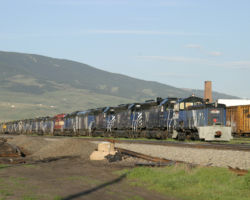
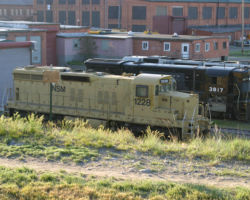
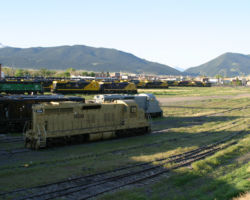
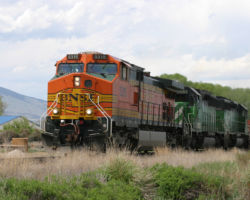
MRL Around Paradise
The MRL between Missoula and Paradise is an interesting section of railroad, having two different main lines through mountainous terrain. The longer, more southerly Fourth Subdivision is the primary route, following a water level grade along the Clark Fork. Followed closely by I-90 between Missoula and St. Regis, and then by MT 135 between St. Regis and Paradise, it’s the Northern Pacific’s former freight main and also the route that the Milwaukee picked through this stretch. Track speeds approach 55 MPH through some stretches, so chasing down any train will be a bit of a challenge.
The Tenth Subdivision connects the same two endpoints, but is shorter and was, at one time, faster. Built in 1883, the Evaro Line, as the route is frequently called, was the NP’s former passenger mainline. Straight out of De Smet, where it breaks off the Fourth Sub, it almost immediately starts the 2.2% climb over Evaro Hill. It can be easily followed by driving MT 200. The routing is usually used by empty eastbounds and by the Polson Local, which starts in Missoula and works over to Dixon, where it heads north towards Polson on the Eleventh Sub.
The Paradise Local was on duty at 0700h at Paradise, Monday through Friday, when I was there in 2003. Still, on Tuesday, the 27th, I’d woken up around 6am, so I headed out west to see what I could catch before the local actually headed out. The local always seem to have switching to do in the yard before leaving, so I figured I’d have plenty of time. Sure enough, out at Thompson Falls, I heard BNSF 1041 east on the radio, so I set up at the east end of town and waited. Turns out BNSF 1041 was followed by BNSF 4366, BNSF 4125, and the so-called “worm train”, so named because it’s a solid unit train of those earthworm-brown BNSF covered hoppers. (Photo #20) This one was an empty, returning from a northwestern port. Track speed through these parts is decent, so my next photo opportunity wasn’t until just outside of Plains. Even then, I only had a minute or two to set things up. (Photo #21) From there, I followed the train down to Paradise and then a few miles east on the Evaro Line. Having seen that the local was almost ready, though, I turned around and headed back to Paradise instead of following the 1041.
The Paradise Local is interesting not only for where it runs, but for what it runs and what it runs by. Usual power for the local is a pair of rebuilt first generation geeps, and this particular time it was MRL 112 and MRL 133, a pair of GP9s (the 112 is ex-NP, but the 133 is ex-CNW, exx-QNSL). Along the 4th sub are several remaining sets of original NP semaphores, yet to be replaced with modern signals. The most famous set is probably at St. Regis, where the line passes under the I-90, ex-US 10, and ex-Milwaukee bridges. The semaphores are just north of the ex-US 10 bridge, and are unusually short so that crews coming west/north could see them under all of the bridges. There are (or at least were, in 2003) also several other semaphores, or sets of semaphores, along this subdivision. In addition to the unusual signalling, there are also several scenic bridges along the route, and the whole thing is easilly fanned from MT 135.
First thing for this particular local would be a run down to the lumber mill at St. Regis. I actually didn’t get back to Paradise quite in time, and had to settle for a shot of it coming south just past the river bridge (Photo #22). As I mentioned before, the Fourth Sub moves along pretty quickly, and it was a challenge to get ahead of the train again for another shot. The opportunity arose, though, at this picturesque crossing of the Clark Fork, seen in Photo #23.
One of the primary reasons the local comes down to St. Regis is to serve a local sawmill and pick up loads of lumber and wood chips. The sawmill is located just north of town, out of sight and fairly inaccessible. So, having nowhere else to go, I waited for what seemed like hours (it was really about 80 minutes) on the former US 10 highway bridge in St. Regis. Conveniently, it has a sidewalk on the north side, making it a perfect shooting location for the local. That said, other locals, like the local sheriff for example, would stop to check on me after having seen me standing there for some time. I think the guy was concerned I might be suicidal or something, since I just stood there staring down from the bridge. Regardless, once he saw the camera, he realized I was just another railfan and went on. I’m guessing he sees a few of us around!
After what seemed like a small eternity, the local finally came around the corner at 1130h. (Photos #24-25) The sawmill doesn’t have a full (double ended) siding apparently, so they bring the local down to the real siding on the south/east side of town to run the power around the train for the return trip. About half an hour later, the local was headed out of town, back to Paradise and points west on the line. I caught it at a small, steep crossing that lead to river access on the north end of town. (Photo #26)
All was not quiet this Tuesday morning, though. While the local was at work, an eastbound BNSF stacker, behind BNSF 4691, had stopped at Toole to meet the returning local. Toole is an island of CTC control in the middle of the ABS stretching from Superior to Paradise, a medium-length CTC-controlled siding in the middle of nowhere. The CTC will creep in from both ends, though, and will eventually close the gap, spelling the end of the Fourth Sub semaphores. Just not today… (2005 update: These will all be gone by the end of the year. The St. Regis blades fell in November of 2004, and all that remain are five between Toole and Quinns.) When I got to Toole, the local was still ahead of me and making good time. All I could catch was the stacker pulling out of the hole…
The race was on – there was only a few miles from Toole to the next semaphore that I wanted to shoot at MP 208.6. I’d spotted this one the day before, and it required a quick sprint through the trees to get to the tracks in order to photograph it. Fortunately, the local got hung up waiting for a signal at West Toole. That was the only thing that worked in my favor and gave me enough time to set the shot up. I’m quite happy with the results, though – see photo #28. (This one, too, is gone today.)
I stopped off at the lodge on my way back to Paradise, just to check in with the wife. I didn’t figure it’d be any great loss, since I expected the local to tie up in the yard, or at least stop for some work. After a brief stop, however, there was some radio chatter about heading west out of Paradise and meeting two. So, off again… I filled the Yukon (ever thirsty for gas, especially with my full throttle-or-brake style of driving that day) and found the Paradise local at Plains, preparing to head into the siding. (Photo #29)
Meet two, eh? As if the ‘spatch could here me, the scanner crackled to life. “Yeah, 112, you’ll be waiting for two. The first one’s the passenger train, and…” My brain crashed at that point. It didn’t really care what train two was – it was much too busy trying to work out what sort of passenger train this might be. A detoured Empire Builder? Some sort of official special? Something else?
Since I wasn’t that happy with Plains as a photo location, and I
wasn’t sure which way the special would turn at Paradise (and thus
needed to actually see it make the junction), I set up at a grade
crossing near the west end of the Paradise yard. A few minutes before
1300h, MRL 651 and 652 (a pair of oddball SD19-1s) come barrelling
through with passenger cars in tow. (Photo #30) As it turned out, the
passenger train was a deadheading move for Montana Rockies Rail Tours
from Sandpoint, ID, to Billings, MT. This was to prepare for trips the
next weekend between Billings and Livingston. The consist, as reported
on the MRL list, was as follows:
- MRL 651/ 652 (SD19-1)
- RQAX 1711 – crew dorm (ex-High Iron)
- RQAX 104 – power car
- RQAX 800148 – bag/dorm
- RQAX 1612 – bag/dorm
- RQAX 4001 – coach
- RQAX 9407 – dome coach
- RQAX 4734 – coach
- RQAX 4700 – ADA coach
- RQAX 9410 – dome coach
- RQAX 3109 – lunch counter/ diner/ gift shop
- RQAX 8750 – “Yellowstone River” – diner
- RQAX 800269 – “City of Livingston” – dome lounge
- RQAX 4013 – coach
- RVIX 800344 – “Yerba Buena” – PV
- RVIX 800212 – “Bella Vista” – PV dome
(Note: Montana Rockies Rail Tours’ website is here, but the company suspended all operations at the end of 2004. I guess it goes with the semaphores in this trip report…)
Being a passenger train, it was only fitting that the movement took the ex-NP passenger main over Evaro at the Paradise junction. That said, while I was excited about seeing a move over Evaro, I was somewhat apprehensive and not knowing what photo opportunities awaited me. Also, heavy smoke from several forest fires was starting to drift in and add a billiant haze to the air, making metering for photography difficult at best. I took the first shot at Perma, where the line comes through a nice little through-truss bridge and rounds a curve. Unfortunately, due to haze in the air and heat distortions, the 480mm-worth of zoom I used for making the bridge shot work was just too much. I had to settle for a standard “rounding the curve” shot. (Photo #31)
Driving just ahead of the train (really driving ahead and scouting for shots, then driving back to the train, repeat…), I didn’t find much that I thought I could turn into a usable shot. I think really, more than not finding usable shots, it was more a case of fatigue and hunger were setting in – I hadn’t eaten lunch, and I hadn’t been sleeping much. So consequently, I wasn’t at the top of my game. I was being a lazy railfan. I decided to photograph it at Dixon for lack of a better shot, where the Eleventh Sub (Polson Branch) splits off the Evaro line, but even then the smoke was hanging thick in the air. (Photo #32) I don’t even remember exactly where the forest fire was, only that it was hundreds of miles away and still managing to screw up the air that badly.
From Dixon, the next good opportunity didn’t really present itself until the top of Evaro Hill itself, when I found a grade crossing just past the crest (or at least a crest in the line, if not the big one). Again, after waiting for what seemed like forever, the special showed up (Photo #33). Even though this was a deadhead move, at least two passengers were along on the rear observation car, taking in the sights. (Photo #34) Now that was the way to see the Evaro line!
Somewhat down from Evaro is the giant steel trestle. It’s about 2 miles above the junction of MT 200 with I-90. Some of you might be wondering why I didn’t shoot the special on the trestle, especially given the fact I had good afternoon light at that point. Simple answer: a wide load move screwed it all up. My chosen parking spot was on the shoulder next to a mobile home storage lot, just west of the trestle but in clear view. A wide load caravan (pilot/chase trucks and the main hauler) was about the head out, and I had to move forward so that they could make the corner on to MT 200. As I was moving the Yukon, the special rolled over the trestle. Oppportunity lost forever. Being mildly upset (since they could have made that corner without me moving the truck…), I called it a day and headed west along I-90, hoping to maybe catch another train or two. No such luck, so I just pulled in at Quinns and enjoyed some time in the hot springs pool, followed by a great dinner and a couple of beers.
The next morning we were headed out for BNSF’s ex-Great Northern High Line through Glacier National Park, and more specifically a couple days at the Isaak Walton Inn in Essex. As usual for this trip, I got up early and headed out, while my wife slept in and then enjoyed a few more minutes in the hot springs. Luck was with me, though, and out near Thompson Falls I encountered an eastbound mix with a rather ratty-looking warbonnet – BNSF 832 – on the point. I followed it back to just west of Plains, where I captured my favorite shot of the trip – 832 winding along the Flathead in the early morning light. (Photo #35). I followed it back to Paradise, where I finally got my bridge shot over the Flathead River (Photo #36). From there, it was back to the lodge to pick up the bags and my wife, then head up for Essex.
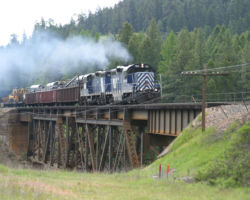
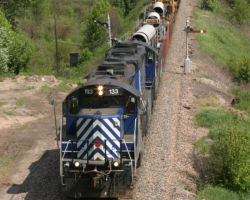
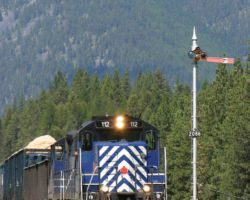
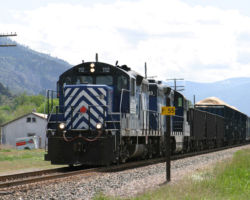
Marias Pass
Wednesday, 28-May-2003, was as much a travel and traditional vacation day as anything – meaning not much in the way of trains. It was a lot of driving, a lot of sight-seeing, a lot of wildlife photography, but not much in the way of trains. Not a terribly long, day, though – we were checked in at the Isaak Walton Inn by 1600h. If there was ever accomodations perfectly suited to railfans, this has to be it. Built in 1939 as Great Northern employee housing for men working on the line, today it serves as some very unique tourist lodging just of US 2 at Essex, MT. The best part is that it backs right up to the BNSF’s ex-GN High Line across Montana, a very busy rail corridor between Chicago and the ports of the Pacific Northwest. (Photos #37-38)
After a wonderful dinner in the Inn’s restaurant, I headed out to hopefully catch one last train for the day. Unfortunately, all I got was a few hours of sitting and a picture of this little hummingbird that wouldn’t leave me alone. (Photo #39) I’m guessing I was too close to his nest or in his territory or some such. The critter just wouldn’t leave me alone – kept dive-bombing me and then sitting on this wire on the pole above.
Thursday looked much better than Wednesday – not a cloud in the sky, and no sign of any smoke. My wife and I ate breakfast downstairs, and then I went out to catch the first expected train of the morning – Amtrak’s eastbound Empire Builder, running about an hour late. (Photo #40) Even though the Inn and BNSF installed a bridge over the line and fences, limiting direct access to the track, they realized their clientele would need certain accomodations… Consequently, the bridge has portals to put camera lenses through, and shots can be easily had from either end of the bridge. Really it’s not as big of an impediment to photography as I’d initially feared. Shortly after Amtrak, BNSF 7824 came through westbound (Photo #41). You can see the bridge in question above the train. Also note the second unit is an SD9 (BNSF 6104), still out earning its keep nearly 50 years after it was built (Dec 1956).
After that, we were going to head out to East Glacier and just take in the park – no real goal of railfanning, but I wouldn’t turn down a train if I wandered across one. About 1100h, we wandered across BNSF 4681 east just out of East Glacier, and headed west again following it. However, some moron (such, as, just for example, yours truly) forgot to set the shutter speed back up and consequently blurred some of the best shots of the trip. That said, a trip down to just west of the summit revealed more trains – one working up and another working down/west (along with 4681, trapped behind the first westbound). Since we were actually headed for East Glacier when we got sidetracked (no pun intended) by 4681 west, we chose to follow the eastbound (BNSF 5415) back in the way we were already going. We caught up with it again near False Summit (Photo #46), so named because it’s a brief respit in the westbound approach to the Marias Pass summit.
The rest of Thursday was spent exploring the park, photographing things other than trains, etc. Thursday night, we decided, we’d head over to Whitefish and find somewhere good to eat. Along the way, we caught up with a train I’d seen earlier at the summit – a stacker powered by three BN-green SD40-2s. They weren’t real BN SD40-2s, because they were now property of First Union, and thus wore FURX reporting marks. Still, if you ignored that, it was just like seeing the BN of the early 1990s in action across Marias again. About 1500h, we found them again, just east of Tunnel 3.8.
Tunnel 3.8 is a half-mile tunnel bored by the GN in 1943 to eliminate several sharp curves in the original grade, which followed the river. Even today, the original grade can be seen curving off to the left of the portal. However, the way Photo #45 is set up, the grade is just out of the frame. We followed the three green 40s down to Coram, where we caught them one more time before heading off for dinner (Photo #46).
Somewhere good turned out to the Mackenzie River Pizza Company, a truly remarkable chain of pizza restaurants local to Montana. Since anybody who knows anything about me knows I view the world using my stomach as a lens, I’ll throw in another culinary tidbit… This is where I first discovered a beer called “Moose Drool” It’s a microbrewed brown ale from Big Sky Brewing in Missoula, and quite possibly one of my favorite beers in all the world. If you like ales, this is one you absolutely have to try. Trust me, it just wouldn’t be one of my trip reports without some comments on restaurants.
After dinner, we went walking around the downtown area to let the food settle a bit. One of the things I remember best about visiting Whitefish as a kid is the Great Northern EMD NW3 #181 parked down by the depot. This little jewel is one of only two that survive – the other is at AE Stanley in Morristown, PA, according to this site. The NW3 was a 1000hp EMD model unique to the Great Northern, of which only seven were built. They were similar to the other GN roadswitcher experiment, the NW5, in that they had a steam generator, allowing them to pull small passenger trains on branch lines.
After getting back in the car, we wandered across yet another displayed locomotive a few miles back east in Columbia Falls, MT. This one was an old Shay, and until recently, I knew next to nothing about it. Now, thanks to ShayLocomotives.com, I have a history for it. This is a 35-ton, two truck, wood burning, standard gauge Lima Shay built for the Great Northern in 1914, which quickly became Somers Lumber #1. See the complete list of info they have about it here. You can see photos of it as photos #48-49.
Before returning to the Inn for the night, we decided to go check if there were any mountain goats down at the Goat Lick, just southeast of Essex. On the far side of the canyon, BNSF’s main spans the creek via Sheep Creek Bridge (or Trestle). As we were leaving, I heard Amtrak hit the horns for the bridge. There’s nothing quite like the chord a P42 cranks out. Almost instinctively I grabbed the camera and captured the westbound Empire Builder on the bridge at about 2100h. (Photo #50)
Friday was supposed to be an easy travel day from Essex back towards Missoula. So, as with many of the other days, I was up and gone at daybreak to get some hard core railfanning in before I picked up my wife and went back into regular vacation mode. The day dawned bright, blue, and otherwise perfect (but a bit cold). With the line around Glacier arranged as a bit of a V, with Essex being near the southernmost tip of the V, I figured my best chances lay to the east, hoping I could catch up with an eastbound.
Sure enough, as I was in the shower, I heard an eastbound blow through Essex. (Yes, I had to get out of the shower and look, I couldn’t tell by listening that it was an eastbound.) The best part is that it wasn’t the morning eastbound Empire Builder. While I like passenger trains, I was much more in the mood to shoot freight over the pass that particular morning. Threw on some clothes, bolted out the door, and the chase was on.
The first workable shot of the day was a little after 0700h at the snowsheds near Java East. A bit further up the pass, I’d seen a shot I wanted the day before. However, it would require low morning light and a bit of a climb to get in position. With this eastbound, things would work out perfectly. So, I drove to the particular bend in US 2 that overlooked the Marias crossovers, and scurried up the hillside. As I was trying to keep my balance on the hillside, the whine of dynamics caught my attention. From the east, BNSF 4816 was gliding downhill from the summit with a train of loaded covered hoppers, probably grain. A couple minutes later, I was able to photograph the two trains passing, with the Montana Rockies in the background. (Photo #52) I followed it on east through Bison (Photo #53) and on down to East Glacier in order to get a photo of it crossing the Midvale Creek Trestle (Photo #54). Of course the other reason I was following it was because the truck was out of gas, and East Glacier has the only liquid dinosaur around. As I was sitting there filling the tank, I noticed that a westbound was coming around the eastbound on the siding, and wasn’t stopping at the west switch. The tank was full, so the chase was on again!
The consist was BNSF 5223 in the lead, followed by whiteface BNSF SD40-2 6321, followed by BNSF 7322. That was the best part about this trip so far – the sheer number of old SD40-2s out still earning their keep, along with a few rare ex-ATSF SD45-2s thrown in as well. Caught up with him first working up the grade at Bison, just west of East Glacier (Photo #55). About halfway back, I could hear somebody hollering at me, but couldn’t quite place it. Then I realized there was a hobo on the train, but he blended in with his car so well that I didn’t even see him until he was about a carlength away. Dangerous and illegal, sure, but if you wanted to do it, I don’t think you could have picked a better morning. I caught the train one more time at the summit, then noticed he was slowing on the downhill on account of a restricting signal at the Marias crossovers.
Radio chatter quickly confirmed what I suspected – the Empire Builder was out of Essex and headed east. I’d never shot the huge bridge at Java, so I figured this would be as good of a time as any – passenger train, eastbound, morning light, etc. The Java bridge is a monumental deck truss and steel trestle bridge that crosses the chasm formed by the Middle Fork of the Flathead River at that point. It’s easily accessed by a dirt path through the forest just west of where US 2 underpasses the railway. You can’t drive out towards the bridge due to a gate (National Park and all…), but you can certainly dump your vehicle safely off the road and start hiking. Well, I started running, mainly because I could already hear the train! It’s really remarkably close to the highway, but you’d never know it was there due to the dense forests. I’ve been up there numerous times and always figured it was a huge hike, but it’s not – a few hundred yards at most. Oh, watch that last step, too – the edges of the canyon out at the end are straight down a couple hundred feet. I didn’t quite make it to the end in time, and instead had to settle for a shot a bit further back. (Photo #57) It’s still a darn impressive, but more so when you actually get out to the preferred angle at the end (Photo #58).
After Amtrak, it was back to Essex to pick up my wife and baggage, check out, and head back for Missoula. Not much railfanning along the way, just driving, looking, and talking. I did find out why the Yukon was burning so darn much gas, though (yes, worse than normal), when I stopped to have its oil changed in Kalispell. Turns out the fuel filter had a smaller-than-pinhole leak in it, almost certainly punctured by something along the way. It wasn’t leaking much, even under high pressure, but enough that it was quickly dripping on the ground. The oil change guys noticed it immediately and called me over with, “Ummm, you might want to look at this…” Luckily it had been spraying the ground, not the hot exhaust or any such other location. Just add that to a laundry list of stuff I hated about that truck…
By the time we got into Missoula, we were just in time to see MRL’s Night Gas Local, loaded and headed west at De Smet. Power was MRL 250, 256, and 351. It had a low green on the north side, so I’m guessing this one was headed up and over Evaro. After that, it just started pouring, so we headed back to the motel and called it a day.
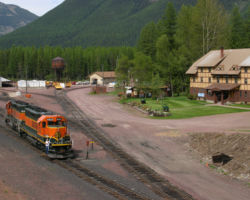
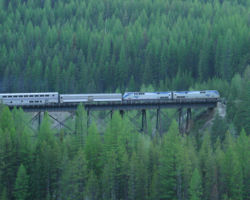
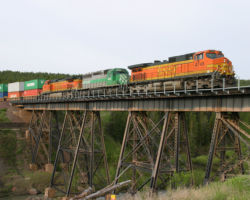
Day in North America 2003 – May 31, 2003
Saturday, 31-May-2003, was CTC Board’s Day in North America, where railfans all over the US come out to capture a day in North American railroad operations on film. Consequently, since we’d be roughly paralleling MRL much of the way back to Billings, I had high hopes for good weather and lots of trains. I should know better than to taunt the weather with such plans, for the weather will always prevail. Sure enough, Saturday dawned foggy, cloudy, and raining. Patently disgusting weather. Still, what’s a little rain to stop a foamer?
The first train of the day was just barely out of Missoula. Thanks to some radio chatter, I had enough warning to pull of the freeway at Piltzville/Turah and catch the incoming M-LAUMIS (train LM), with MRL 310 up front. (Photo #60) Conveniently, we then caught up behind the M-MISLAU (Missoula – Laurel, ML for short) just about 20 miles outside of Missoula. This cleared up why I could hear the dispatcher talking to MRL 351, yet that wasn’t what was leading the LM I caught first. Made a whole lot more sense… This was near perfect, since I’ve always wanted to shoot an eastbound through the Nimrod tunnel that’s right along the freeway. (Photo #61)
Since MRL and I-90 (along with the ex-Milwaukee alignment) all run parallel along the river, it only made sense to just keep leapfrogging the ML for a few miles. Here it is again at Jens (Photo #62). Like I said, the Milwaukee was once in the mix, and at Jens the old MILW grade is only a hundred yards or so from the MRL/ex-NP alignment (Photo #63). Just use your imagination for a second – those power lines on the left once supported catenary that fed the Joes, Boxcabs, etc. Electrification is now just a memory, with the last electrics running in June of 1974, and the last diesel freight in mid-March of 1980. Tracks were pulled shortly afterwards, leaving the last transcontinental completed as the first one to be pulled up.
At Garrison, the Northern Pacific split into two mainlines, much as they did between De Smet and Paradise out west. The northern line along today’s US 12 over Mullan Pass and through Helena was the primary freight route. The shorter, steeper southern route through Butte and over Homestake Pass formed the primary passenger route. Today, all MRL freight flows over the northern line. Of the southern line, Homestake Pass is long idled (embargoed in 1983, but not yet abandoned), the Montana Western / BNSF operates the line between Garrison and Butte on lease from BNSF, and MRL operates the east end from just east of Three Forks west to just beyond Whitehall. (As a note, when these were taken, the Montana Western still controlled the line from Garrison to Butte. A month later, on 23-Jun-2003, BNSF regained control of this line and now operates it themselves.) As one last few of the ML, we see it getting ready to switch out cars at Garrison for the Montana Western to come pick up. (Photo #64)
The Rarus Railway is one of those things I’ve always heard of but never been able to actually track down. It operates about 26 miles of line between Butte and Anaconda that was originally built by the Butte, Anaconda, & Pacific back in the 1890s. When mining ceased at Butte, the line was up for abandonment, but saved by the state in 1985. Rarus purchased the property in 1990, and continues to operate occasional trains today. They have a small fleet of 8 GP7s and GP9s from various sources, all (to my knowledge) painted in their attractive yellow and black scheme (which is nearly identical to the original 1960s-era BA&P diesel paint scheme, and in fact many of the locomotives are ex-BAP). I’d never seen one, that is until 31-May-2003, when I stumbled across Rarus 302 moving some cars of dirt around near Silver Bow. (Photo #65) Always being a closet birder (sure, I can admit to being a railfan, but a birder? Just kidding…), I found something else I’d never seen only a few hundred yards from the train – a wetland filled with yellow-headed blackbirds. (Photo #66) Odd how the color schemes on both the blackbirds and the Rarus geep match? Anyway, don’t ask me any railfan questions about the Rarus, because I just don’t know!
East of Butte, all was quiet again until Bozeman Pass, where once again I caught up with an empty PGE coal train headed east back to the Powder River Basin. I caught it once on the ascent (Photo #67), and then again at Muir, just on the east side of the summit tunnel (Photo #68). From there, it was quiet again until Livingston, just outside Billings. There, I came up on this oddity going down the freeway. I decided that we must be declaring war on North Dakota, or getting ready for that giant Canadian offensive we all know is coming. (A big smirk goes out to all my Canadian friends… Photo #69) Finally, I’ll leave you with the last train I saw for the trip. On our way to dinner that night, we wandered across the Montana Rockies Rail Tours train again, this time parked at the Billings depot. (Photo #70)
Anyway, I hope you’ve enjoyed this, and I hope I haven’t made too many factual errors. If you spot any, let me know. I’m writing this nearly two years after it happened, relying on photos and notes from the trip to make sense of it all. Thanks!
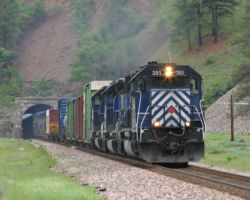
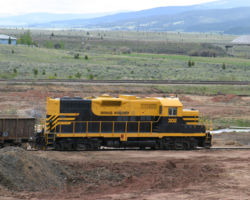
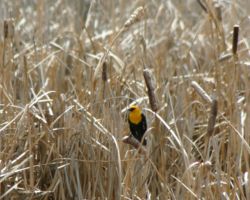
All photographs in this trip report were taken with a Canon EOS 10D using either a Canon 28-105mm USM or a Canon 75-300mm f4-5.3 IS/USM.
This work is copyright 2024 by Nathan D. Holmes, but all text and images are licensed and reusable under a Creative Commons Attribution-NonCommercial-ShareAlike license. Basically you’re welcome to use any of this as long as it’s not for commercial purposes, you credit me as the source, and you share any derivative works under the same license. I’d encourage others to consider similar licenses for their works.
